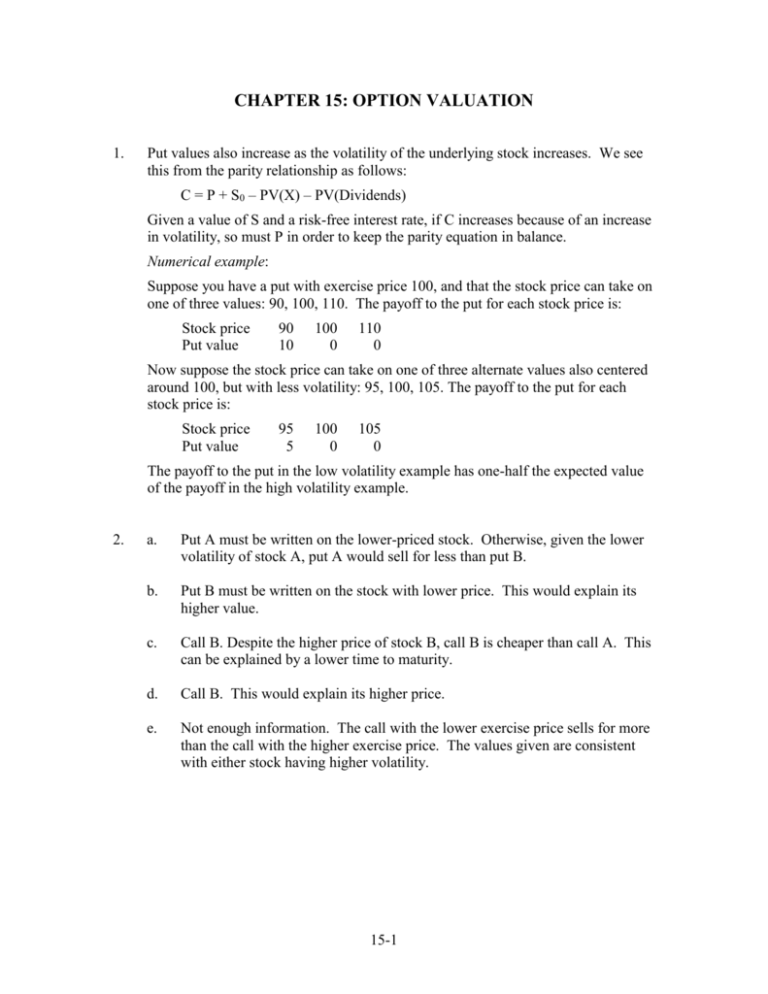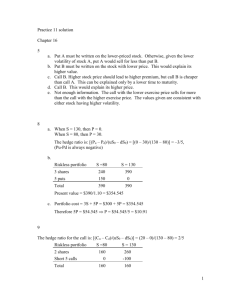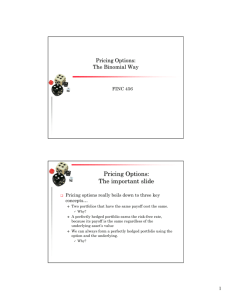Document
advertisement

CHAPTER 15: OPTION VALUATION 1. Put values also increase as the volatility of the underlying stock increases. We see this from the parity relationship as follows: C = P + S0 – PV(X) – PV(Dividends) Given a value of S and a risk-free interest rate, if C increases because of an increase in volatility, so must P in order to keep the parity equation in balance. Numerical example: Suppose you have a put with exercise price 100, and that the stock price can take on one of three values: 90, 100, 110. The payoff to the put for each stock price is: Stock price Put value 90 10 100 0 110 0 Now suppose the stock price can take on one of three alternate values also centered around 100, but with less volatility: 95, 100, 105. The payoff to the put for each stock price is: Stock price Put value 95 5 100 0 105 0 The payoff to the put in the low volatility example has one-half the expected value of the payoff in the high volatility example. 2. a. Put A must be written on the lower-priced stock. Otherwise, given the lower volatility of stock A, put A would sell for less than put B. b. Put B must be written on the stock with lower price. This would explain its higher value. c. Call B. Despite the higher price of stock B, call B is cheaper than call A. This can be explained by a lower time to maturity. d. Call B. This would explain its higher price. e. Not enough information. The call with the lower exercise price sells for more than the call with the higher exercise price. The values given are consistent with either stock having higher volatility. 15-1 3. Note that, as the option becomes progressively more in the money, its hedge ratio increases to a maximum of 1.0: X 115 100 75 Hedge ratio 85/150 = 0.567 100/150 = 0.667 125/150 = 0.833 S 45 50 55 d1 -0.0268 0.5000 0.9766 X 50 25 10 Hedge ratio 150/150 = 1.000 150/150 = 1.000 150/150 = 1.000 4. 5. a. N(d1) 0.4893 0.6915 0.8356 When S = 130, then P = 0. When S = 80, then P = 30. The hedge ratio is: [(Pu – Pd)/(uS0 – dS0) = [(0 – 30)/(130 – 80)] = –3/5 b. Riskless portfolio S = 80 S = 130 3 shares 5 puts 240 150 390 0 Total 390 390 Present value = $390/1.10 = $354.545 c. Portfolio cost = 3S + 5P = $300 + 5P = $354.545 Therefore 5P = $54.545 P = $54.545/5 = $10.91 6. The hedge ratio for the call is: [(Cu – Cd)/(uS0 – dS0)] = (20 – 0)/(130 – 80) = 2/5 Riskless portfolio S = 80 S = 130 2 shares Short 5 calls 160 0 260 -100 Total 160 160 –5C + 200 = $160/1.10 = $145.455 C = $10.91 Put-call parity relationship: P = C – S0 + PV(X) $10.91 = $10.91 + ($110/1.10) – $100 = $10.91 15-2 7. d1 = 0.3182 N(d1) = 0.6248 d2 = –0.0354 N(d2) = 0.4859 Xe–rT = $47.56 C = S0 N(d1) Xe–rT N(d2) = $8.13 8. P = $5.69 This value is from our Black-Scholes spreadsheet, but note that we could have derived the value from put-call parity: P = C – S0 + PV(X) = $8.13 – $50 + $47.56 = $5.69 9. A straddle is a call and a put. The Black-Scholes value is: C + P = S0eT N(d1) Xe–rT N(d2) + Xe–rT [1 N(d2)] S0eT [1 N(d1)] = S0eT [2 N(d1) 1] + Xe–rT [1 2N(d2)] On the Excel spreadsheet (Spreadsheet 15.1 in the text), the valuation formula is: B5*EXP(B7*B3)*(2*E4 1) + B6*EXP(B4*B3)*(1 2*E5) 10. a. C falls to $5.5541 b. C falls to $4.7911 c. C falls to $6.0778 d. C rises to $11.5066 e. C rises to $8.7187 11. The hedge ratio of the straddle is the sum of the hedge ratios for the two options: 0.4 + (–0.6) = –0.2 12. The call price will decrease by less than $1. The change in the call price would be $1 only if: (i) there were a 100% probability that the call would be exercised; and (ii) the interest rate were zero. 13. Holding firm-specific risk constant, higher beta implies higher total stock volatility. Therefore, the value of the put option increases as beta increases. 15-3 14. Holding beta constant, the stock with high firm-specific risk has higher total volatility. Therefore, the option on the stock with a lot of firm-specific risk is worth more. 15. The call option with a high exercise price has a lower hedge ratio. The call option is less in the money. Both d1 and N(d1) are lower when X is higher. 16. The call option is more sensitive to changes in interest rates. The option elasticity exceeds 1.0. In other words, the option is effectively a levered investment and is more sensitive to interest rate changes. 17. The call option’s implied volatility has increased. If this were not the case, then the call price would have fallen. 18. The put option’s implied volatility has increased. If this were not the case, then the put price would have fallen. 19. As the stock price becomes infinitely large, the hedge ratio of the call option [N(d1)] approaches one. As S increases, the probability of exercise approaches 1.0 [i.e., N(d1) approaches 1.0]. 20. The hedge ratio of a put option with a very small exercise price is zero. As X decreases, exercise of the put becomes less and less likely, so the probability of exercise approaches zero. The put's hedge ratio [N(d1) –1] approaches zero as N(d1) approaches 1.0. 21. a. The spreadsheet appears as follows: INPUTS Standard deviation (annual) Maturity (in years) Risk-free rate (annual) Stock Price Exercise price Dividend yield (annual) 0.3213 0.5 0.05 100 105 0 The standard deviation is: 0.3213 15-4 OUTPUTS d1 d2 N(d1) N(d2) B/S call value B/S put value 0.0089 -0.2183 0.5036 0.4136 8.0000 10.4076 b. The spreadsheet below shows the standard deviation has increased to: 0.3568 INPUTS Standard deviation (annual) Maturity (in years) Risk-free rate (annual) Stock Price Exercise price Dividend yield (annual) 0.3568 0.5 0.05 100 105 0 OUTPUTS d1 d2 N(d1) N(d2) B/S call value B/S put value 0.0318 -0.2204 0.5127 0.4128 9.0000 11.4075 Implied volatility has increased because the value of an option increases with greater volatility. c. Implied volatility increases to 0.4087 when maturity decreases to four months. The shorter maturity decreases the value of the option; therefore, in order for the option price to remain unchanged at $8, implied volatility must increase. INPUTS Standard deviation (annual) Maturity (in years) Risk-free rate (annual) Stock Price Exercise price Dividend yield (annual) d. OUTPUTS d1 d2 N(d1) N(d2) B/S call value B/S put value -0.0182 -0.2541 0.4928 0.3997 8.0001 11.2646 Implied volatility decreases to 0.2406 when exercise price decreases to $100. The decrease in exercise price increases the value of the call, so that, in order to the option price to remain at $8, implied volatility decreases. INPUTS Standard deviation (annual) Maturity (in years) Risk-free rate (annual) Stock Price Exercise price Dividend yield (annual) e. 0.4087 0.33333 0.05 100 105 0 0.2406 0.5 0.05 100 100 0 OUTPUTS d1 d2 N(d1) N(d2) B/S call value B/S put value 0.2320 0.0619 0.5917 0.5247 8.0010 5.5320 The decrease in stock price decreases the value of the call. In order for the option price to remain at $8, implied volatility increases. INPUTS Standard deviation (annual) Maturity (in years) Risk-free rate (annual) Stock Price Exercise price Dividend yield (annual) 0.3566 0.5 0.05 98 105 0 15-5 OUTPUTS d1 d2 N(d1) N(d2) B/S call value B/S put value -0.0484 -0.3006 0.4807 0.3819 8.0000 12.4075 22. A put is more in the money, and has a hedge ratio closer to –1, when its exercise price is higher: Put A B C X 10 20 30 Delta -0.1 -0.5 -0.9 23. a. Position ST < X ST > X Stock Put ST + D X – ST ST + D Total X+D 0 ST + D Position ST < X ST > X Call Zeroes 0 X+D ST – X Total X+D b. X+D ST + D The total value for each of the two strategies is the same, regardless of the stock price (ST). c. The cost of the stock-plus-put portfolio is (S0 + P). The cost of the call-pluszero portfolio is: [C + PV(X + D)]. Therefore: S0 + P = C + PV(X + D) This is the put-call parity relationship in equation 15.3. 24. a. (i) Index increases to 5964. The combined portfolio will suffer a loss. The written calls will expire in the money; the protective put purchased will expire worthless. Let’s analyze the outcome on a per-share basis. The payout for each call option is £214, for a total cash outflow of £428. The stock is worth £5964. The portfolio will thus be worth: £5964 £428 = £5536 The net cost of the portfolio when the option positions are established is: £5680 + £68 (put) [2 £36] (calls written) = £5676 (ii) Index remains at 5680. Both options expire out of the money. The portfolio will thus be worth £5680 (per share), compared to an initial cost 30 days earlier of £5676. The portfolio experiences a very small gain of £4. (iii) Index declines to 5396. The calls expire worthless. The portfolio will be worth £5650, the exercise price of the protective put. This represents a small loss of £26 compared to the initial cost 30 days earlier of £5676. 15-6 25. b. (i) Index increases to 5964. The delta of the call will approach 1.0 as the stock goes deep into the money, while expiration of the call approaches and exercise becomes essentially certain. The put delta will approach zero. (ii) Index remains at 5680. Both options expire out of the money. Delta of each will approach zero as expiration approaches and it becomes certain that the options will not be exercised. (iii) Index declines to 5396. The call is out of the money as expiration approaches. Delta approaches zero. Conversely, the delta of the put approaches 1.0 as exercise becomes certain. c. The call sells at an implied volatility (11.00%) that is less than recent historical volatility (12.00%); the put sells at an implied volatility (14.00%) that is greater than historical volatility. The call seems relatively cheap; the put seems expensive. a. The delta of the collar is calculated as follows: Stock Short call Long put Total Delta 1.0 – N(d1) = –0.35 N(d1) – 1 = –0.40 0.25 If the stock price increases by $1, the value of the collar increases by $0.25. The stock will be worth $1 more, the loss on the short put is $0.40, and the call written is a liability that increases by $0.35. b. 26. a. b. If S becomes very large, then the delta of the collar approaches zero. Both N(d1) terms approach 1 so that the delta for the short call position approaches – 1.0 and the delta for the long put position approaches zero. Intuitively, for very large stock prices, the value of the portfolio is simply the (present value of the) exercise price of the call, and is unaffected by small changes in the stock price. As S approaches zero, the delta of the collar also approaches zero. Both N(d1) terms approach 0 so that the delta for the short call position approaches zero and the delta for the long put position approaches –1.0. For very small stock prices, the value of the portfolio is simply the (present value of the) exercise price of the put, and is unaffected by small changes in the stock price. Choice A: Calls have higher elasticity than shares. For equal yen investments, the capital gain potential for calls is higher than for stocks. Choice B: Calls have hedge ratios less than 1.0. For equal numbers of shares controlled, the yen exposure of the calls is less than that of the stocks, and the profit potential is less. 15-7 27. Step 1: Calculate the option values at expiration. The two possible stock prices are: S+ = $120 and S– = $80. Therefore, since the exercise price is $100, the corresponding two possible call values are: Cu = $20 and Cd = $0. Step 2: Calculate the hedge ratio: (Cu – Cd)/(uS0 – dS0) = (20 – 0)/(120 – 80) = 0.5 Step 3: Form a riskless portfolio made up of one share of stock and two written calls. The cost of the riskless portfolio is: (S0 – 2C0) = 100 – 2C0 and the certain end-of-year value is $80. Step 4: Calculate the present value of $80 with a one-year interest rate of 5% = $76.19 Step 5: Set the value of the hedged position equal to the present value of the certain payoff: $100 – 2C0 = $76.19 Step 6: Solve for the value of the call: C0 = $11.90 Notice that we never use the probabilities of a stock price increase or decrease. These are not needed to value the call option. 28. Step 1: Calculate the option values at expiration. The two possible stock prices are: S+ = $130 and S– = $70. Therefore, since the exercise price is $100, the corresponding two possible call values are: Cu = $30 and Cd = $0. Step 2: Calculate the hedge ratio: (Cu – Cd)/(uS0 – dS0) = (30 – 0)/(130 – 70) = 0.5 Step 3: Form a riskless portfolio made up of one share of stock and two written calls. The cost of the riskless portfolio is: (S0 – 2C0) = 100 – 2C0 and the certain end-of-year value is $70. Step 4: Calculate the present value of $70 with a one-year interest rate of 5% = $66.67 Step 5: Set the value of the hedged position equal to the present value of the certain payoff: $100 – 2C0 = $66.67 Step 6: Solve for the value of the call: C0 = $16.67 The value of the call is now greater than the value of the call in the lowervolatility scenario. 29. a. Over two periods, the stock price must follow one of four patterns: up-up, updown, down-down, or down-up. To construct a 2-period stock price lattice for a 2-year option, each period consists of 365 days, for a total of 730 days. We calculate u and d for this example as follows: u e t 1.2214 d 1 u 1 0.8187 1.2214 15-8 The binomial parameters are: u = 1 + percentage increase in a period if the stock price rises = 1.2214 d = 1 + percentage decrease in a period if the stock price falls = 0.8187 r = 1 + risk-free rate = 1.06184 The two-period binomial tree is as follows: $74.59 $61.07 $50.00 $50.00 $50.00 $40.94 $33.52 The calculations for the values shown above are as follows: uS0 = $50 × 1.2214 = $61.07 dS0 = $50 × 0.8187 = $40.94 uuS0 = $61.07 × 1.2214 = $74.59 udS0 = $61.07 × 0.8187 = $50.00 duS0 = $40.94 × 1.2214 = $50.00 ddS0 = $40.94 × 0.8187 = $33.52 b. For each terminal stock price, a call option has a specific value. Because the company does not pay any dividend, δ = 0. (For a dividend-paying stock, the dividend yield is subtracted from the risk-free rate.) The probability of an upward stock price movement in any period is: u e (r - )t d u-d 1.06184 0.8187 0.6038 1.2214 0.8187 The probability of a downward stock price movement in any period is: 1 – 0.6038 = 0.3962 15-9 The value of a call option at expiration is: max (0, S – X) where: S = current price of stock index X = exercise price of the call option The two-period binomial tree for the option values is as follows: $14.59 $8.30 $0.00 $4.72 $0.00 $0.00 $0.00 The calculations for the values shown above are as follows: Period 2: Cuu = max (0, S – X) = max (0, $74.59 – $60.00) = max (0, $14.59) = $14.59 Cud = max (0, S – X) = max (0, $50.00 – $60.00) = max (0, –$10.00) = $0.00 Cdu = max (0, S – X) = max (0, $50.00 – $60.00) = max (0, –$10.00) = $0.00 Cdd = max (0, S – X) = max (0, $33.52 – $60.00) = max (0, –$26.48) = $0.00 Period 1: $14.59 × 0.6038 (probability of a upward stock movement) = $8.81 $0.00 × 0.3962 (probability of a downward stock movement) = $0.00 $0.00 × 0.6038 (probability of a upward stock movement) = $0.00 $0.00 × 0.3962 (probability of a downward stock movement) = $0.00 With r = 1.06184, the values for the call in period 1 are: Cu = ($0.00 + $8.81)/1.06184 = $8.30 Cd = ($0.00 + $0.00)/1.06184 = $0.00 15-10 Period 0: $8.30 × 0.6038 (probability of a upward stock movement) = $5.01 $0.00 × 0.3962 (probability of a downward stock movement) = $0.00 With r = 1.06184, the value of the call in period 0 is: ($5.01 + $0.00)/1.06184 = $4.72 Alternatively: uu C uu ud C ud du C du dd C dd r2 (0.6038 2 14.59) (0.6038 0.3962 0) (0.3962 0.6038 0) (0.3962 2 0) $4.72 1.06184 2 C c. The period 2 option values are computed as follows: Puu = max (0, X – S) = max (0, $60.00 – $74.59) = max (0, –$14.59) = $0.00 Pud = max (0, X – S) = max (0, $60.00 – $50.00) = max (0, $10.00) = $10.00 Pdu = max (0, X – S) = max (0, $60.00 – $50.00) = max (0, $10.00) = $10.00 Pdd = max (0, X – S) = max (0, $60.00 – $33.52) = max (0, $26.48) = $26.48 Period 1: $0.00 × 0.6038 (probability of a upward stock movement) = $0.00 $10.00 × 0.3962 (probability of a downward stock movement) = $3.96 $10.00 × 0.6038 (probability of a upward stock movement) = $6.04 $26.48 × 0.3962 (probability of a downward stock movement) = $10.49 With r = 1.06184, the values for the put in period 1 are: Pu = ($0.00 + $3.96)/1.06184 = $3.73 Pd = ($6.04 + $10.49)/1.06184 = $15.57 Period 0: $3.73 × 0.6038 (probability of a upward stock movement) = $2.25 $15.57 × 0.3962 (probability of a downward stock movement) = $6.17 With r = 1.06184, the value of the put in period 0 is: ($2.25 + $6.17)/1.06184 = $7.93 d. The put-call parity relationship is: C – P = S0 – Xe-rt Substituting the values for this problem: $4.72 – $7.93 = $50.00 – $60e-0.06 × 2 = –$3.21 15-11 30. S0 = 100 (current value of portfolio) X = 100 (floor promised to clients, 0% return) = 0.25 (volatility) r = 0.05 (risk-free rate) T = 4 years (horizon of program) a. The put delta is: N(d1) – 1 = 0.7422 – 1 = –0.2578 Place 25.78% of the portfolio in bills, 74.22% in equity ($74.22 million) b. At the new portfolio value, the put delta becomes –0.2779, so that the amount held in bills should be: ($97 million 0.2779) = $26.96 million. The manager must sell $1.18 million of equity and use the proceeds to buy bills. 31. a. Stock price Put payoff 110 0 90 10 The hedge ratio is: –0.5 A portfolio comprised of one share and two puts provides a guaranteed payoff of 110, with present value: $110/1.05 = $104.76 Therefore: S + 2P = $104.76 $100 + 2P = $104.76 P = $2.38 b. The cost of the protective put portfolio is the cost of one share plus the cost of one put: $100 + $2.38 = $102.38 c. The goal is a portfolio with the same exposure to the stock as the hypothetical protective put portfolio. Since the put’s hedge ratio is –0.5, we want to hold (1 – 0.5) = 0.5 shares of stock, which costs $50, and place the remaining funds ($52.38) in bills, earning 5% interest. Stock price S = 90 S = 110 Half share Bills 45 55 55 55 100 110 Total This payoff is identical to that of the protective put portfolio. Thus, the stock plus bills strategy replicates both the cost and payoff of the protective put. 15-12 32. We start by finding the value of Pu . From this point, the put can fall to an expirationdate value of Puu = $0 (since at this point the stock price is uuS0 = $121) or rise to a final value of Pud = $5.50 (since at this point the stock price is udS0 = $104.50, which is less than the $110 exercise price). Therefore, the hedge ratio at this point is: H Puu Pud $0 $5.50 1 uuS 0 udS 0 $121 $104.50 3 Thus, the following portfolio will be worth $121 at option expiration regardless of the ultimate stock price: Riskless portfolio Buy 1 share at price uS0 = $110 udS0 = $104.50 $104.50 $121.00 16.50 0.00 $121.00 $121.00 Buy 3 puts at price Pu Total uuS0 = $121 The portfolio must have a current market value equal to the present value of $121: 110 + 3Pu = $121/1.05 = $115.238 Pu = $1.746 Next we find the value of Pd . From this point (at which dS0 = $95), the put can fall to an expiration-date value of Pdu = $5.50 (since at this point the stock price is duS0 = $104.50) or rise to a value of Pdd = $19.75 (since at this point, the stock price is ddS0 = $90.25). Therefore, the hedge ratio at this point is 1.0, which reflects the fact that the put will necessarily expire in the money if the stock price falls to $95 in the first period: H Pdu Pdd $5.50 $19.75 1.0 duS 0 ddS0 $104.50 $90.25 Thus, the following portfolio will be worth $110 at option expiration regardless of the ultimate stock price: Riskless portfolio Buy 1 share at price dS0 = $95 Buy 1 put at price Pd Total ddS0 = $90.25 duS0 = $104.50 $90.25 19.75 $104.50 5.50 $110.00 $110.00 The portfolio must have a current market value equal to the present value of $110: 95 + Pd = $110/1.05 = $104.762 Pd = $9.762 Finally, we solve for P using the values of Pu and Pd . From its initial value, the put can rise to a value of Pd = $9.762 (at this point, the stock price is dS0 = $95) or fall to a value of Pu = $1.746 (at this point, the stock price is uS0 = $110). Therefore, the hedge ratio at this point is: H Pu Pd $1.746 $9.762 0.5344 uS 0 dS0 $110 $95 15-13 Thus, the following portfolio will be worth $60.53 at option expiration regardless of the ultimate stock price: Riskless portfolio dS0 = $95 uS0 = $110 Buy 0.5344 share at price S = $100 Buy 1 put at price P $50.768 9.762 $58.784 1.746 Total $60.530 $60.530 The portfolio must have a market value equal to the present value of $60.53: $53.44 + P = $60.53/1.05 = $57.648 P = $4.208 Finally, we check put-call parity. Recall from Example 15.1 and Concept Check #4 that C = $4.434. Put-call parity requires that: P = C + PV(X) S $4.208 = $4.434 + ($110/1.052) $100 Except for minor rounding error, put-call parity is satisfied. 15-14









